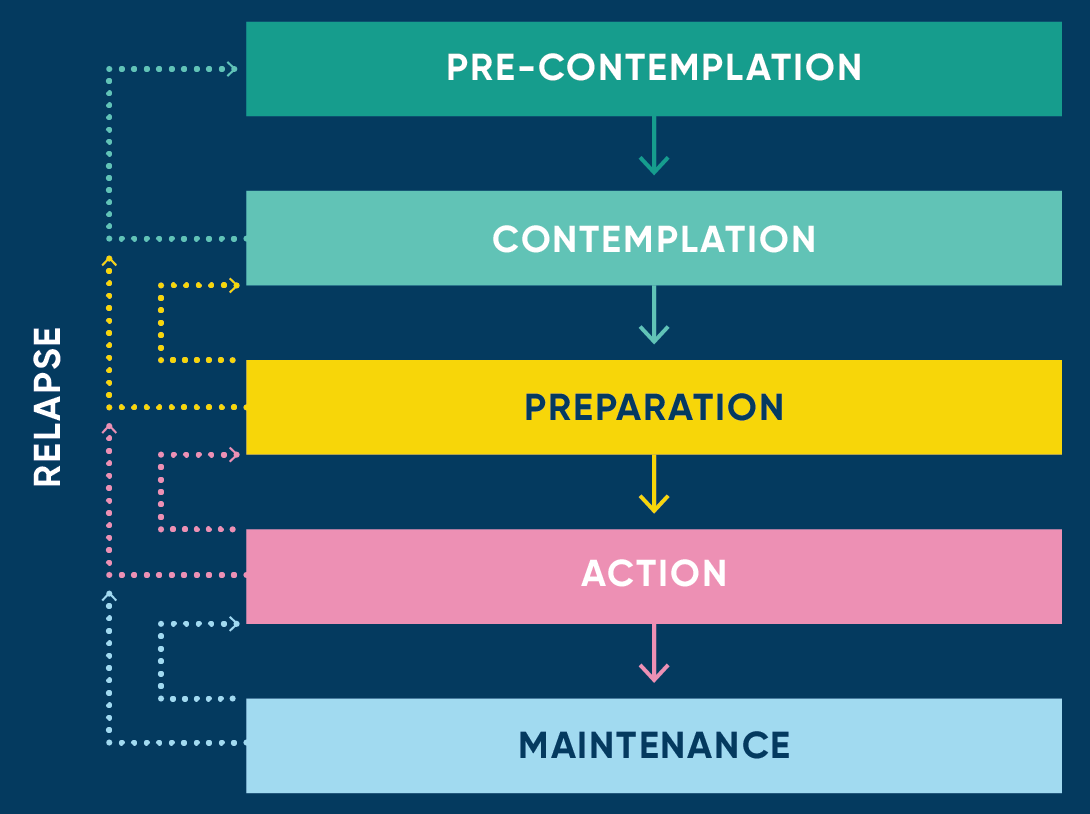People are motivated to engage in healthy behaviour for different reasons and will engage in health and wellbeing depending on their level of readiness, priorities, and resources.
When you’re involving your team in the health and wellbeing journey, and when you begin to put strategies to your priorities, you need to understand how health is determined and how people may become motivated.
A person’s health is determined by many factors, some of which can be outside of their control. These factors include genetics, family situation, education level, employment status and type of work, past and ongoing trauma, socio-economic status, and where a person lives. Healthy also means different things to different people.
The stages of change model is useful to understand where people may be at in making healthy changes.1
Stages of change model
The stages of change model describes five stages of behaviour.
- Pre-contemplation: the person is unaware that their behaviour is unhealthy or not interested in changing.
- Contemplation: the person is weighing up the pros and cons of changing their behaviour.
- Preparation: the person is planning on changing their unhealthy behaviour.
- Action: the person is in the process of changing their unhealthy behaviour.
- Maintenance: the person has adopted the new healthy behaviour and ceased the unhealthy behaviour.

Workplace health and wellbeing strategies often target people in the latter stages of change (preparation, action and maintenance) through activities such as exercise classes. However, the challenge is to identify strategies that will target and engage those in the earlier stages (pre-contemplation and contemplation).
Workplaces gain the most from improving people’s health who are in the earliest stages of readiness, as these are usually the least healthy within the workforce. The actions you choose to implement as part of your health and wellbeing strategy, like introducing a new policy or making changes to the environment, can positively influence all employees, even those who appear disengaged. For example, if a workplace introduced a healthy catering policy and swapped the biscuit jar for a fruit bowl, the eating habits of all employees will be positively influenced.
What could this look like in practice? We’ve included some examples of strategies across different stage changes in the table
that you can use to help people create change.
| Ways to communicate and promote your strategy2 | ||
|---|---|---|
| Stage of change | Workplace strategies | Examples that address physical inactivity |
Pre-contemplation: unaware of unhealthy behaviour, not ready to change or think it’s too hard to change |
|
|
Contemplation: considering changing unhealthy behaviour |
|
|
Preparation: planning to change unhealthy behaviour |
|
|
Action: process of changing unhealthy behaviour |
|
|
Maintenance: adoption of healthy/ cessation of unhealthy behaviour |
|
|
Source: Adapted from the Government of Western Australia Department of Health. Toolkit for a Healthier Workplace.
1 Boston University School of Public Health, The transtheoretical model (stages of change), Boston University School of Public Health, accessed 2022. bu.edu
2 Live Lighter, Toolkit for a healthier workplace, Live Lighter, 2021.


